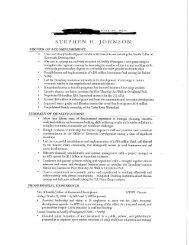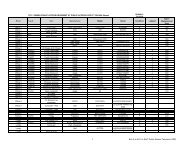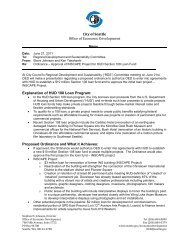2013 Water System Plan, Volume II - Seattle City Clerk's Office - City ...
2013 Water System Plan, Volume II - Seattle City Clerk's Office - City ...
2013 Water System Plan, Volume II - Seattle City Clerk's Office - City ...
Create successful ePaper yourself
Turn your PDF publications into a flip-book with our unique Google optimized e-Paper software.
pressure and friction on the bottom surface of the block. To keep the pipe from sliding<br />
within the collar, the concrete needs to interface with the pipe. The wedge restraints on<br />
ductile iron pipe should be wrapped in polyethylene so the concrete does not seep into<br />
the wedges of the wedge restraint gland and stop it from working.<br />
i<br />
ii<br />
Steel Pipe<br />
If using concrete collars on a steel pipe, a factory integrated thrust ring must be welded<br />
around a pipe section, then embed in concrete.<br />
Ductile Iron Pipe<br />
If using concrete collars on ductile iron pipe, a factory ring must be installed on a pipe<br />
section. An alternative is to install two wedge style restraints face-to-face to act as a<br />
thrust ring.<br />
iii Poor Soil Conditions<br />
Design should consider the potential settlement impact the concrete thrust collar could<br />
have on the pipe.<br />
iv Pipe Anchors/Tie Backs<br />
Pipe anchors consist of a large mass of concrete usually on one side of a pipeline. The<br />
concrete is attached to the pipeline by steel rods. Anchors act like vertical thrust blocks<br />
(except in a horizontal plane) to restrain the pipe at a bend. Typically, pipe anchors are<br />
only installed for temporary service because the rods can corrode.<br />
C. Rigid Restrained Joints<br />
Flanges, welded joints, and threaded couplings are types of rigid restrained joints.<br />
Flanges can be used on both ductile iron and steel pipes. SPU does not use threaded<br />
couplings in water mains.<br />
i<br />
ii<br />
Flanges<br />
SPU does not recommend burying flanges in soil. Flanged fittings are used where joint<br />
flexibility is not needed and are typically found in vaults associated with valves or other<br />
appurtenances. Flanged pipe must be installed perfectly to fit up and offers no<br />
flexibility. A dismantling joint must be used to allow disassembly and repairs. Flanged<br />
valves are usually used in the installation of a large run of flexible restrained joint pipe.<br />
Each flanged valve will have a short flange by flexible restrained joint adapter on each<br />
side of it.<br />
Manufacturers can weld a flange to the steel pipe. See AWWA Manual M-11 for the<br />
class of flange rating. Consult with the manufacturer to ensure the flanged connection<br />
can be provided. An electrical isolation kit may be necessary if joining the steel pipeline<br />
to a ductile iron appurtenance. Steel and ductile iron are dissimilar materials that can<br />
corrode.<br />
Welded Joints<br />
Steel pipe can be assembled with welded joints, making the pipeline fully restrained.<br />
Field-welded joints provide restraint against the unbalanced hydrostatic and<br />
hydrodynamic forces acting on the pipe. There are several styles of welded joints. The<br />
5-26 SPU Design Standards and Guidelines
















